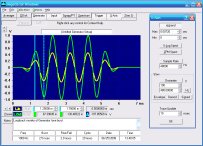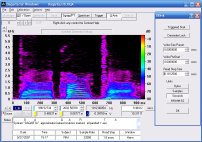![[LogoShip]](logo5.png)
Software for Windows
Science with your Sound Card!


Features:
Oscilloscope
Spectrum Analyzer
8-Channel
Signal Generator
(Absolutely FREE!)
Spectrogram
Pitch Tracker
Pitch-to-MIDI
DaqMusiq Generator
(Free Music... Forever!)
Engine Simulator
LCR Meter
Remote Operation
DC Measurements
True RMS Voltmeter
Sound Level Meter
Frequency Counter
Period
Event
Spectral Event
Temperature
Pressure
MHz Frequencies
Data Logger
Waveform Averager
Histogram
Post-Stimulus Time
Histogram (PSTH)
THD Meter
IMD Meter
Precision Phase Meter
Pulse Meter
Macro System
Multi-Trace Arrays
Trigger Controls
Auto-Calibration
Spectral Peak Track
Spectrum Limit Testing
Direct-to-Disk Recording
Accessibility
Data Logger
Waveform Averager
Histogram
Post-Stimulus Time
Histogram (PSTH)
THD Meter
IMD Meter
Precision Phase Meter
Pulse Meter
Macro System
Multi-Trace Arrays
Trigger Controls
Auto-Calibration
Spectral Peak Track
Spectrum Limit Testing
Direct-to-Disk Recording
Accessibility
Applications:
Frequency response
Distortion measurement
Speech and music
Microphone calibration
Loudspeaker test
Auditory phenomena
Musical instrument tuning
Animal sound
Evoked potentials
Rotating machinery
Automotive
Product test
Contact us about
your application!
User Line SPL
Controls: Calibration Menu >> User Units >> User Line
Macro: UserSPL
Sound pressure is typically measured in Pascals, but it is usually much more convenient as dB SPL (Sound Pressure Level). This button allows display of SPL in Y-log (power spectrum) mode whenever User Units is active.
One Pascal of pressure is 93.9794 dB SPL, so SPL mode will cause all dB values to be increased by that amount.
The SPL button is enabled whenever Y-log is active in Spectrum display mode and the Units Name is 'Pa' (Pascal). Typically, that will be when the selected User Line uses a .CAL or .FRD file that has units of 'Pa' or 'SPL'. However, if you don't have a .CAL or .FRD file but you know that your microphone or other transducer has a flat frequency response in the region of interest, you can set the name to 'Pa' manually, and set the appropriate Units/Volt. This will enable the SPL button.
Note that once SPL is active, the Units Name will be disabled to prevent changing it from 'Pa'. To change the Name to something else, you must first toggle SPL off from Y-log mode.
Macro Notes:
If the relevant User Line dialog is open, and the above conditions are met such that the SPL button is enabled, UserSPL=1 will activate, UserSPL=0 will deactivate, and UserSPL=x will toggle the SPL state.
To change the SPL state directly when the dialog is not open, use a Uxx. prefix before the macro command to specify which line it refers to, as in U0L.UserSPL=1.
U0L. through U7R. specify Input lines 0-7 and the Left or Right channel of each.
If your card has only Master Input lines, UIL. or UIR. prefixes will specify them here.
If your card has only Master Output lines, specify them with UOL. or UOR. prefixes.
Otherwise, UWL. and UWR. prefixes specify Wave Out lines.
If a data file is open, UIL. and UIR. prefixes specify Left and Right Input lines, while UOL. and UOR. specify Output lines.
UserSPL?0 is a read-only variable that returns the peak value, in dB, of the entries in a calibration file (.CAL or .FRD) loaded for channel 0. You may use channels 0-3 here, given as a single digit. Alternatively, you can use V to specify the current Ch Channel Select number. A default value of 0.0 dB is returned for a channel number outside the 0-3 range, whether specified directly or via the V option.
0 = Left In
1 = Right In
2 = Left Out
3 = Right Out
V = Ch value (0-3)
The calibration file must be loaded for the given channel, but does not have to be in actual use. The returned peak is the most-positive dB value in the list of Frequency,dB pairs. The 'Sens:' file entry is ignored.
For input channels 0 or 1 the return value takes into account whether your sound card has separate input lines and if so which one is selected. Likewise, for output channels 2 or 3 it considers whether the sound card has separate Wave controls or uses only Master volume.
See Macro Data Unit Conversions for a discussion of how to use this variable together with others to obtain actual volts or User Units from ADC or DAC values returned by certain macro math and macro array functions.
See also User Units dialog, User Line Dialog, dB, Formulas For Working With Sound
- Back to User Line Units Name
- Ahead to Options Menu
- Daqarta Help Contents
- Daqarta Help Index
- Daqarta Downloads
- Daqarta Home Page
- Purchase Daqarta
Questions? Comments? Contact us!
We respond to ALL inquiries, typically within 24 hrs.INTERSTELLAR RESEARCH:
Over 35 Years of Innovative Instrumentation
© Copyright 2007 - 2023 by Interstellar Research
All rights reserved